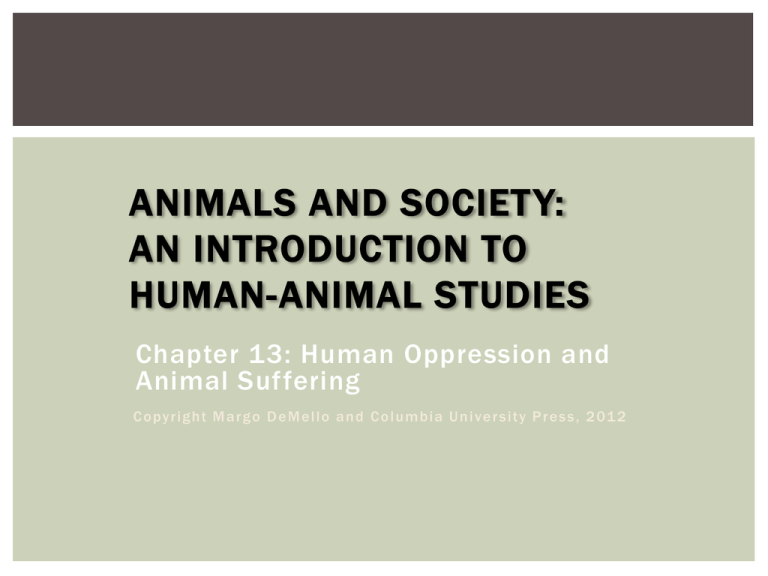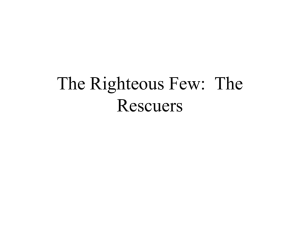
ANIMALS AND SOCIETY:
AN INTRODUCTION TO
HUMAN-ANIMAL STUDIES
Chapter 13: Human Oppression and
Animal Suffering
C o py r i g h t M a r g o D e M e l l o a n d C o l um b i a U n i v e r s i t y P r e s s , 2 01 2
INTERLINKED SYSTEMS
All animals are not treated the same. Depending on how one is
classified, they may be raised to be slaughtered and eaten, they
may be raised to be experimented upon, or they may be raised
to be kept as a companion and given love and attention.
Likewise, not all humans are treated, by other humans, the
same. Great numbers of people suffer from poverty, disease,
warfare and crime, and about half of all humans on the planet
live on less than $2.50 per day.
According to many scholars, these two situations —animal
suffering and exploitation, and human suffering and
exploitation—are linked.
The same systems of oppression that keep humans from
reaching their full potential, such as the class system, the caste
system, racism, or slavery, also work to oppress animals.
The reverse may also be true: the systems of animal
exploitation found in, for example, the meat industry or the
biomedical industry, can also be said to exploit some humans,
while giving other humans profit.
THE RISE OF INEQUALIT Y
With the domestication of animals, humans began to control
the bodies and products of animals.
Not coincidentally, the domestication of animals (and plants)
also coincided with the rise of human oppression over other
humans. The earliest civilizations arose thanks to the
domestication of plants and animals, and all included vast
dif ferentials in wealth, and all depended heavily on slave labor.
It may well be that the decision to use some humans as slaves
derived from the use of animals as food and labor sources.
Cer tainly, the ways that human slaves and animal proper ty were
both bought, sold, branded and confined were ver y similar.
THE RISE OF INEQUALIT Y
Women, too, saw their status in society drop with the rise of
state level civilizations. Women’s status in foraging cultures
was relatively equal to men; only men’s control over hunting
increased their status. But for the most par t, women in such
cultures contributed a great deal to the economy and held high
status. But af ter the domestication of both plants and animals,
women were relegated to domestic and reproductive labor,
while men began to control the fruits of production —the crops
and the animals both.
THE RISE OF INEQUALIT Y
The ancient states, with their built -in systems of inequality,
led to other forms of social stratification like the caste
system in India.
With the rise of colonialism in the fifteenth century, and
the conquest of non-Western cultures by the European
superpowers, a new system of inequality arose, based on
race. In racialized cultures, the physical dif ferences
between human communities are thought to correlate with
important psychological, intellectual, emotional and
cultural dif ferences, and those supposed dif ferences are
then used as the justification for segregating out the
“inferior” groups and denying them access to resources and
power.
OTHERING AND ESSENTIALIZING
Othering refers to the practice of making people —or
animals—different in order to justify treating them
dif ferently.
Racism, for example, depends on othering: by claiming that
people are racially dif ferent —that there is something
inherent, or essential, within us that makes us not only look
dif ferent, but think, feel and act dif ferently, and that these
dif ferences can be summed up by the term “race” —we can
more easily subjugate them and exclude them from power.
The further we can distance those that we don’t like or don’t
want to share resources with, the more we can mistreat
them.
Animals, too, are “ othered.”
OTHERING AND ESSENTIALIZING
The human-animal divide, developed after the domestication
of animals, involves the construction of a metaphorical
border which separated out all of the animal species from a
single animal species —human—and gave that species power
over all the others. The border has been based on qualities
like language, rationality and the soul.
Another aspect that links the treatment of animals with the
treatment of some humans is essentializing: the treatment of
individuals as if they were the same as others in their
race/sex/species.
Racist thought is by definition essentialist thought, and so is
speciesist thought. All Chinese are the same; all pigs are the
same.
OTHERING
One critical way in which women, the poor, and racial
minorities in particular have been othered historically is by
using animal terms to refer to them.
In 1790, British political philosopher Edmund Burke used the
term “swinish multitude” to refer to the supporters of the
French Revolution, whom he saw as ignorant, dangerous, and
“swinish.” Burke, like other elites of his time, saw the poor as
being poor because of their inherent, essential qualities. Only
the upper classes shared these qualities, leaving the lower
classes in a semi-human state, and deserving of ill treatment. Dehumanization, and essentializing, necessarily
precedes, because it serves to justify, oppression.
OTHERING
The line between those deserving of good treatment, and
those who don’t deserve it, is a fuzzy one, and must
constantly shift to accommodate the desires of those in
power. Just as not all humans deserve fair treatment —slaves,
the poor, minorities, immigrants, untouchables, and gays —
not all animals deserve poor treatment. Some animals are
considered to be more worthy than others, either because of
the pleasure that they give us, or the economic value that
they possess.
The danger lies in the line itself —as long as there exists in
society a line separating out some from others, then is any
group truly safe from being on the losing side of it?
ANIMAL FARM
A masterpiece of political satire, Animal Farm is a tale
of oppressed individuals who long for freedom but
ultimately are corrupted by assuming the very power
that had originally oppressed them.
The story traces the deplorable conditions of
mistreated farm animals. After extreme negligence by
their owner, the animals revolt and expel Mr. Jones and
his wife from the farm.
The tale of the society the animals form into a
totalitarian regime is generally viewed as Orwell's
critique of the communist system in the former Soviet
Union.
“Some animals are more equal than others.”
ANIMAL FARM
In explaining how he came to write Animal
Farm, Orwell says he once saw a little boy
whipping a horse and later he wrote,
“It struck me that if only such animals became
aware of their strength we should have no power
over them, and that men exploit animals in much
the same way as the rich exploit the [worker].”
SEXISM AND SPECIESISM
Feminists scholars have long discussed the ways in which
women are defined by and even constrained by their
bodies. Because women menstruate, give birth, and
lactate, cultures have long treated women as
fundamentally dif ferent from men, and have often created
rituals and taboos associated with those female activities.
Women’s bodies are often the site of political contestation
and control, regarding everything from birth control to
weight to beauty.
Both women and animals have historically been considered
less intelligent than men. Tactics like objectification,
ridicule have been and continue to be used to control and
exploit both women and animals. Women are called names
like cow, sow, pig, dog, bitch, fox and hen; by symbolically
associating them with animals, they are trivialized.
SEXISM AND SPECIESISM
In the fourth century BCE, Aristotle wrote that because
only men possess rationality, it was natural and necessary
for men to rule women and animals (as well as slaves),
both of whom lacked it. Women, slaves and animals,
existed to serve the needs of man.
In the 1970s, anthropologist Sherry Ortner, in attempting
to explain why women are universally subordinated to men,
created an explanation which argued that women are
symbolically associated with nature, and men are
associated with culture, and nature occupies a subordinate
position to culture.
SEXISM AND SPECIESISM
Animals, too, are constrained by their bodies, and are indeed defined
by their reproductive abilities. For example, the hormone replacement
drug Premarin is made from the urine of pregnant hor ses
Other female animals are likewise exploited for their reproductive
abilities. Dair y cows are repeatedly impregnated so that their bodies
will produce milk; but instead of that milk being used to feed their
own babies, the babies are removed (and male calves are sold to veal
production facilities) and the mothers are milked to produce dair y for
humans.
Egg-laying hens are confined to tiny cages without enough room to
spread their wings or lie down, are kept in the dark at all hour s, and
their beaks are burnt of f to keep them from pecking the other birds to
death.
Because men have long had more power —political, social, economic,
and physical—than both women and animals, they have been able to
use that power to master both. For instance, in most pastoral
societies, only men are able to own animals, and women are simply
the proper ty of fathers and husbands, just like cattle or sheep.
SEXISM AND SPECIESISM
The consumption of meat is another example. Meat
eating has long been associated with men and
masculinity, and meat has been eaten by elites and
others with power throughout history, while
women, children and the poor have eaten what was
thought to be second class food —breads, fruits and
vegetables. Even today, vegetable eating —and
especially salad eating—is considered to be weak
food, or “rabbit food.”
SEXISM AND SPECIESISM
Carol Adams shows how both animals and women are
objectified, fragmented, and ultimately consumed.
Animals are treated as objects, killed, dismembered, and
consumed as meat, while women are objectified, and through
pornography, dismembered into body parts (breasts, lips,
butt, vagina), and then “consumed” through porn or through
sexual violence.
When women say that they “felt like a piece of meat,” they
are referring to degrading and dehumanizing treatment that
is reserved for both women and animals, but never men.
In addition, many men who want to control their wives and
girlfriends do so through not only using violence, and threats
of violence, against them, but by committing violence against
the women’s companion animals as well.
RACISM AND ANIMALIZATION
Like women, non-whites have been compared to animals
since at least the time of colonialism, and certainly since
the African slave trade emerged in the seventeenth
century.
Europeans and Euro- Americans referred to both Native
Americans and Africans as animals, and many people
subscribed to the Christian idea of the Great Chain of
Being.
By the nineteenth century, with the rise of evolutionary
thought, many people felt that while all humans may be
related to apes, some humans were closer to apes than
others, and Africans in particular were thought to be the
“missing link” between apes and humans.
Scientists of the day were in
agreement that apes and
blacks were very similar. In
this picture, from a book by
Robert Knox called The Races
of Men (1851), the slant of the
brow is used to draw
connections between the
“Negro” and the “Oran Outan”
and differences between
those two and the “European.”
In this image from a book
called The Types of Mankind
(1854), we see a depiction
of the great chain of being
with Apollo at the top (the
most perfect human), a
black person below, and an
ape below him.
In 1868, Ernst Haeckel’s
Natürliche
Schöpfungsgeschichte was
published. In the book,
this image appeared (his
perfect person was
German, not Greek):
This image appeared
in the The Evolution of
Man (1874 edition) as
part of an argument
that blacks are
evolutionarily close to
apes
SLAVERY AND ANIMALIZATION
African Americans were not just thought of as animals; they
were treated like animals. Treating a human like an animal is a
way to degrade and dehumanize them.
African slaves were shackled and muzzled like animals, beaten
like animals, branded like animals, bought and sold like
animals, had their children taken from them like animals, and
had their humanity and individuality ignored, just as humans
do with animals. They were property just as animals were, and
could be legally killed by their property owner, just as animals
could.
Whites justified their use of, and treatment of, slaves with a
number of justifications. Blacks could not feel pain, they could
not feel love towards their children, and they were happier
under slavery than living on their own. In addition, slavery was
an important part of the economy of the American south —how
could plantation owners expect to do without it?
RACISM AND ANIMALIZATION
In the years after slavery known as the Jim Crow
period, blacks were still thought of as beastly, as
unable to control their desires.
Whites thought that blacks were more prone to
violence and rape (especially rape of white women)
than were whites, and lynchings of blacks were
common.
Blacks were sometimes displayed in zoos and in
circus and carnival side shows alongside wild
animals.
RACISM AND ANIMALIZATION
Even in the twenty-first century, the
association of blacks with monkeys and
apes still has not disappeared.
In the months leading up to the 2008
Presidential election in the United States,
and in the years following the election of
the first African American President, the
internet has been rife with cartoons and
images of Barack Obama (or Michelle
Obama, the First Lady) represented as a
monkey or ape.
ANIMALIZATION AND JEWS
The German word for “race,” rasse, is also the word for
a purebred animal, demonstrating not only the Nazis’
tendency to animalize people but also their concern
with maintaining “blood purity” in both animals and
people.
Jews were called vermin, rats and cockroaches in Nazi
speeches and in the German media.
The caricature
suggests the Jews
are sucking the
economic life from
Gentiles. It is one of
numerous Stürmer
cartoons comparing
Jews to inhuman and
unpleasant animals.
(February 1930)
Where something is rotten, the
Jew is the cause.
The names in the background
are those of Jews involved in
major financial scandals. The
apple is named “the German
economy.” The worm is named
“Jewish scandals.” (November
1931, Stürmer )
Der Pudelmopsdackelpinscher
(The Poodle-Pug-DachshundPinscher)
This children’s book is a story
book, in which each story
compares the Jews to animals
like poisonous snakes,
tapeworms, bedbugs, locusts,
hyenas, mongrel dogs, and
bacteria.
This book is like other children’s
books of the time which contain
short stories telling them how to
recognize a Jew, his criminal and
mean nature and so on.
Jews are still animalized today,
as in this image from Arab News,
which shows Jewish rats sporting
Stars of David and skullcaps,
scurrying back and forth through
holes in the wall of “Palestine
House.” The cartoon may be
inspired by a scene from the
Nazi film “Jew Suess,” in which
Jews are depicted as vermin to
be eradicated by mass
extermination.
ANIMALIZATION AND JEWS
But as with slavery, the animalization of Jews went far
beyond name calling. During the eugenics movement,
the practice of animal breeding —breeding those with
the desirable characteristics and killing and sterilizing
the rest—became the inspiration and example for
eugenic ef forts to upgrade the human population in
both countries.
These ef forts led to compulsory sterilization of the
disabled in the United States and compulsory
sterilization, euthanasia killings, and ultimately,
genocide in Nazi Germany.
ANIMALIZATION AND JEWS
From 1942 to 1945, European Jews were
transported in cattle cars to death camps, some
were tattooed with ID numbers like livestock, and
were slaughtered en masse, with their humanity
and individuality completely extinguished.
The camps themselves were modelled on American
stockyards and slaughterhouses. Nazis borrowed
features intended to make the processing of Jews
at the campus as speedy and ef ficient as possible,
and to streamline the final part of the operation
which took the victims to their deaths. Rudolf
Hoss, the commandant of Auschwitz, called that
camp “the largest human slaughterhouse that
history had ever known.”
“ETERNAL TREBLINKA”
Many writers have noted the similarity of treatment of animals
in slaughterhouses and Jews in the death camps.
Jewish author Isaac Bashevis Singer famously wrote, “for the
animals, it is an eternal Treblinka,” while German philosopher
Theodor Adorno wrote, “Auschwitz begins whenever someone
looks at a slaughterhouse and thinks: they're only animals.”
Because of what appear to be obvious similarities between the
treatment of humans by other humans in the context of
institutions like slavery, and the treatment of animals in animal
agriculture or biomedicine, animal rights activists and
organizations have used these comparisons to draw public
attention to the treatment of animals in contemporar y society.
IS THERE ANY THING WRONG WITH
MAKING COMPARISONS LIKE THIS?
WHY?
WHAT’S WRONG WITH COMPARISONS?
Jewish organizations have been especially horrified at the
comparison between animal agriculture and the Holocaust.
Jewish groups say that campaigns like this trivialize the
horrific loss of human life by comparing humans to chickens
or pigs.
Roberta Kalechofsky, President of Jews for Animal Rights,
has pointed out that Jews were killed during the Holocaust by
people who hated them, while humans, even while killing
animals, do not hate them.
Most people hate these images because comparing animal
suf fering to human suf fering reduces the impact of the
human suf fering.
RACISM AND ANIMAL ADVOCACY
Because of the animal practices found in other cultures,
some Western animal advocates come to the conclusion that
those cultures are less “civilized” than Western cultures, who
don’t practice animal sacrifice for example.
As easy as it is to dehumanize groups of people by comparing
them to animals, it is similarly easy to condemn ethnic
groups and nationalities when working to save animals.
By calling people who engage in cruel -seeming acts
barbarians or savages, especially when ignoring similarly
cruel activities in one’s own country, is not just hypocritical
but verges on racism and cultural imperialism.
CAPITALISM AND EXPLOITATION
Many scholars suggest that both human and animal
oppression have escalated with the rise of capitalism as an
economic system.
In capitalism, animals (resource) and humans ( labor) are
both exploited in order to produce profit.
The poorest people must do the brutal work to ensure that
the system continues —they work in the slaughterhouses, on
the factory farms, and in the packing houses, where they too
are treated “like animals.” Work here is dangerous and jobs
are found in communities made up of the poor and often
minorities. Meat packing plants even advertise in Mexico to
attract the poorest and most vulnerable populations to work
in their factories.










